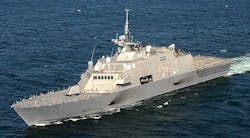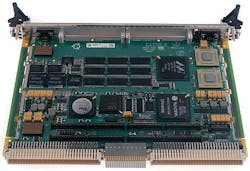Navy chooses 6U VME single-board computers from Curtiss-Wright for shipboard radar
JOINT BASE MCGUIRE-DIX-LAKEHURST, N.J., 27 Jan. 2013. U.S. Navy radar experts needed 6U VME single-board computers based on Freescale MPC7447A/7448 processors with AltiVec technology for radar systems aboard the littoral combat ships USS Little Rock (LCS 9) and USS Sioux City (LCS 11). They found their solution from Curtiss-Wright Controls Defense Solutions in Ottawa.
Officials of the Naval Air Warfare Center Aircraft Division Lakehurst at Joint Base McGuire-Dix-Lakehurst, N.J., announced this month they plan to award a contract to Curtiss-Wright to provide 434 SVME-183 6U VME embedded computing boards for the AN/UPX 29A interrogator system and AN/UPX-24(V) interrogator sets on the Little Rock and Sioux City.
Navy experts also will use the Curtiss-Wright SVME-183 computer boards for the Navy's AN/TPS-59(V)3 tactical missile defense radar, which can detect and track aircraft and missiles at ranges as far as 300 nautical miles. The value of the Navy contract to Curtiss-Wright has yet to be negotiated.
The AN/TPS-59 from the Lockheed Martin Corp. Mission Systems and Training segment in Syracuse, N.Y., is a three-dimensional solid-state linear-phased array surveillance radar that operates in the D band (1215-1400 MHz), and has 54 transmitters that operate independently, and can also operate in the two-dimensional mode should its general-purpose computer fail.
The Curtiss-Wright VME-183 single-board computer uses the single/dual Power Architecture MPMC7447A/7448 microprocessor with AltiVec technology from Freescale Semiconductor in Austin, Texas. The board also has as much as two gigabytes of DDR SDRAM solid-state memory.
The board has two 64-bit PCI Mezzanine Card (PMC) sites, one supporting 100 MHz PCI-Express, and an I/O Ethernet, as many as six serial ports, as many as two MIL-STD-1553 channels, SCSI, SATA, and two USB 2.0 ports.
Curtiss-Wright engineers designed the VME-183 single-board computer for data and digital signal processing in tactical aircraft, armored vehicles, and harsh-environment naval systems such as the littoral combat ship.
Navy officials say they intend to award Curtiss-Wright a five-year firm fixed price indefinite delivery indefinite quantity contract for the computer boards, which have a unique feature called an interface personality module that enables users to route signals on the embedded computer to specific VME P-zero and P-two pins of their choosing.
Curtiss-Wright is the copyright holder of the SVME-183-18B8 interface personality module circuit design, embedded firmware, and board support package, Navy officials say, and the company retains the proprietary data rights and is the only vendor capable of providing this hardware and software.
The AN/UPX-29(V) interrogator system is a centralized identification-friend-or-foe (IFF) system that employs a challenge and reply technique to distinguish friendly platforms in a multi-target environment.
The system has an electronically-steered antenna (ESA) that functions independently of the radar antenna for the immediate interrogations of pop-up targets. The AN/UPX-29 is used with any radar with trigger and antenna bearing signals.
For more information contact Curtiss-Wright Controls Defense Solutions online at www.cwcdefense.com, Lockheed Martin Mission Systems and Training at www.lockheedmartin.com/us/mst, Freescale Semiconductor at www.freescale.com, or the Naval Air Warfare Center Aircraft Division Lakehurst at www.navair.navy.mil.


